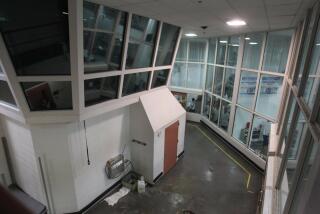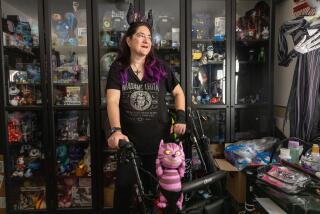Stabbing Victim Got Substandard Care at Disneyland, 2 Testify
A lawsuit challenging Disneyland’s medical and security services reached midpoint Tuesday after two experts testified that treatment of a visitor who was stabbed in the park and later bled to death was substandard.
Today, Disneyland lawyers will begin their defense of the $60-million damage claim filed by the parents of Mel C. Yorba, who died after he was stabbed in Tomorrowland by another park visitor in 1981.
Paramedics were not called to treat Yorba, and the care he received from a park nurse was definitely below standards for emergency medical care, according to testimony Tuesday of a trauma surgeon and a former county medical official.
Stabbed in Lower Heart
“It was not, certainly, the standard of care which the paramedics are expected to perform,” said Dr. Kenneth Ransom, who heads the trauma program for St. Mary’s Hospital in Long Beach.
Yorba was stabbed through the muscle at the lower tip of the heart, with the wound opening the left ventricle. Ransom, who practices only in trauma centers, said he had treated a dozen patients with similar wounds.
“Approximately half of them survived,” Ransom said. Asked if such a wound is fatal, he testified, “Not in and of itself, no.”
Another witness for Clarence and Ellen Reynolds, Yorba’s parents, testified that standard medical practice gives top priority to maintenance of breathing in life-threatening emergencies, while a Disneyland manual put control of bleeding at the top of the list.
“It’s way below the standard of care for the County of Orange at that time,” testified Robert Heilig, who was assistant director of the Orange County Emergency Medical Services agency and coordinator of the county trauma care program from 1977 to 1980.
‘Only God Knows’
“The order of procedures are not in keeping with any known standards in the country, much less Orange County,” Heilig testified.
When questioned by Disneyland lawyer Richard E. McCain, Ransom said that it would be impossible to say whether paramedics could have saved Yorba. Asked the same question in a brief interview after his testimony, Heilig replied: “Only God knows.”
The Disneyland nurse who treated Yorba testified earlier that she had applied pressure to two stab wounds and then performed mouth-to-mouth resuscitation while Yorba was driven in the back of a park van to Palm Harbor Hospital two miles away. The van had no lights or siren, and the driver testified that he had to stop at two or three stoplights on the 10- to 12-minute trip.
Some key points testified to by Heilig, who had served as a mobile intensive care nurse directing paramedics before joining Emergency Medical Services:
- Paramedics could have arrived within two minutes. Heilig testified that a nearby fire station staffed with a paramedic vehicle was available to respond at the time of the stabbing.
The timing of the medical care received by Yorba has emerged as a critical issue in the case. A park visitor who saw the stabbing said it took 20 minutes before a Disneyland nurse arrived to take over Yorba’s care in Tomorrowland. Ike Isaacson, Disneyland security manager, testified earlier that the van left the park for the hospital nine minutes after his office was first notified of the stabbing.
- Paramedics would have taken Yorba to Anaheim Memorial Hospital, one of the county’s five licensed trauma centers established for immediate care of people with life-threatening injuries, Heilig said. Ransom said that designated trauma centers are “better prepared to take care of a patient such as this.”
Yorba was taken to Palm Harbor Hospital, which maintained an emergency room but was not designated a trauma center.
- The trip in the paramedic van or ambulance to the trauma center would have taken seven minutes, Heilig estimated.
- Paramedics would immediately have begun treatment much more extensive than that Yorba received from Disneyland nurse Elizabeth Santy Micco, said Heilig, who had reviewed medical records of the case at the request of John Luetto, attorney for the Lawrences.
Paramedics would have quickly begun intravenous replenishment of blood fluids and electronic monitoring of Yorba’s heart rhythms. They also would have applied surgical wrappings to the legs to reduce circulation, force more blood into the upper body and ease the burden on the patient’s heart, both Heilig and Ransom testified.
Heilig testified that it was difficult to say whether Yorba’s very shallow breathing would have justified the use of a resuscitator, a machine to “physically drive pure oxygen into his lungs.” But a resuscitator would have been “much more effective than mouth-to-mouth” resuscitation, which Micco rendered, according to Heilig.
A portion of the written Disneyland medical policy statement indicated that in all life-threatening situations, paramedics should be called. Heilig said he approved of that portion of park policy.
Micco testified that she had never before seen that paragraph. Micco testified last week that she had been directed orally not to call paramedics into the amusement park.
James O’Driscoll of San Diego was convicted of second-degree murder in the Yorba stabbing and is now serving 16 years to life.
Also testifying Tuesday was Yorba’s mother, who was not present at the stabbing. Ellen Reynolds, 49, testified that her family was close knit, and that Mel and his brother, Mark, 27, also a plaintiff in the lawsuit, helped with her antique business. Reynolds testified that she and Yorba were active in the Baptist Church and made regular trips together to Mexico to work with orphans.
More to Read
Sign up for Essential California
The most important California stories and recommendations in your inbox every morning.
You may occasionally receive promotional content from the Los Angeles Times.










